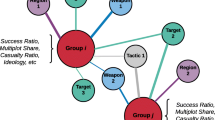Abstract
No single profile fits all CBRN-active groups, and therefore it is important to identify multiple profiles. In the analysis of terrorist organizations, linear and generalized regression modeling provide a set of tools to apply to data that is in the form of cases (named groups) by variables (traits and behaviors of the groups). We turn the conventional regression modeling “inside out” to reveal a network of relations among the cases on the basis of their attribute and behavioral similarity. We show that a network of profile similarity among the cases is built in to standard regression modeling, and that the exploitation of this aspect leads to new insights helpful in the identification of multiple profiles for actors. Our application builds on a study of 108 Islamic jihadist organizations that predicts use or pursuit of CBRN weapons.
Access this chapter
Tax calculation will be finalised at checkout
Purchases are for personal use only
Preview
Unable to display preview. Download preview PDF.
Similar content being viewed by others
References
Ackerman, G.: Defining Knowledge Gaps within CBRN Terrorism Research. In: Ranstorp, M., Normark, M. (eds.) Unconventional Weapons and International Terrorism: Challenges and New Approaches, pp. 13–25. Routledge, London (2009)
Ackerman, G.: The Future of Jihadists and WMD. In: Ackerman, G., Tamsett, J. (eds.) Ji-hadists and Weapons of Mass Destruction, pp. 359–400. CRC Press, Boca Raton (2009)
Asal, V.H., Rethemeyer, R.K.: Islamist Use and Pursuit of CBRN Terrorism. In: Ackerman, G., Tamsett, J. (eds.) Jihadists and Weapons of Mass Destruction, pp. 335–358. CRC Press, Boca Raton (2009)
Ivanova, K., Sandler, T.: CBRN Attack Perpetrators: An Empirical Study. Foreign Policy Analysis 3, 273–294 (2007)
Mowatt-Larssen, R.: Al Qaeda Weapons of Mass Destruction Threat: Hype Or Reality? Harvard Kennedy School Belfer Center for International Affairs, Cambridge (2010)
Raab, J., Milward, H.B.: Dark Networks as Problems. J. Public Adm. Res. Theory 13, 413–439 (2003)
Belsley, D.A., Kuh, E., Welsch, R.E.: Regression Diagnostics: Identifying Influential Data and Sources of Collinearity. John Wiley, Hoboken (2004)
Pregibon, D.: Logistic Regression Diagnostics. The Annals of Statistics 9, 705–724 (1981)
Ragin, C.C.: Redesigning Social Inquiry: Fuzzy Sets and Beyond. University of Chicago Press, Chicago (2008)
Paul, C., Clarke, C.G., Grill, B.: Victory has a Thousand Fathers: Sources of Success in Counterinsurgency. RAND Corporation document number MG-964-OSD (2010)
Author information
Authors and Affiliations
Editor information
Editors and Affiliations
Rights and permissions
Copyright information
© 2011 Springer-Verlag Berlin Heidelberg
About this paper
Cite this paper
Breiger, R.L. et al. (2011). Application of a Profile Similarity Methodology for Identifying Terrorist Groups That Use or Pursue CBRN Weapons. In: Salerno, J., Yang, S.J., Nau, D., Chai, SK. (eds) Social Computing, Behavioral-Cultural Modeling and Prediction. SBP 2011. Lecture Notes in Computer Science, vol 6589. Springer, Berlin, Heidelberg. https://doi.org/10.1007/978-3-642-19656-0_5
Download citation
DOI: https://doi.org/10.1007/978-3-642-19656-0_5
Publisher Name: Springer, Berlin, Heidelberg
Print ISBN: 978-3-642-19655-3
Online ISBN: 978-3-642-19656-0
eBook Packages: Computer ScienceComputer Science (R0)




